The 14th CSA World Computer Shogi Championship
Kazusa Academic Park, Kisarazu, Japan
May 2-4, 2004
PDF file (42K)
Introduction
This year I was particularly looking forward to the CSA world computer shogi
championships. This was not because my own program SPEAR had suddenly become
much stronger, because it hadn't. The main reason was that I was looking forward
to three days of computer shogi. Last year, I only arrived on the evening of the
first day, played the second day and left early on the day of the finals. This year,
because of a move from Saga to Yamagata (which is still not that close, but much closer),
I could stay until after the final round was finished. Furthermore, because I lost my
seeded position last year, I would have to start from the bottom of the tournament and
with a bit of luck I would be able to play two full days.
Luck was indeed what I needed, because not only had I changed jobs just a month before the
tournament (which included a 1200 kilometer move), I also had just become a father. Privately
things couldn't be better, but such things really mess up tournament preparation. In the
end, I had to enter the tournament with a half-baked, badly tested version. It wasn't even
clear if the current version was better than last year's. Still, to test a new program there
is nothing better than a tournament, so I never even considered entering last year's version.
I was quite confident that the new version would be good enough to clear the first preliminary
stage. Confidence that was not based on much, as it turned out.
The First Preliminary Stage
The number of entries in the first preliminary stage was a little disappointing. When
the deadline for entries closed in December, 62 programs had applied, but in the
end only 43 made it to the tournament. 24 of these played in the first preliminary round for
eight spots in the second preliminary round. There were only two new programs this
year (Kuma and Inaka Shodan) and these programs finished at the bottom of the table. As the
average playing level of the programs is increasing, it seems harder and harder to make a
new program. No Bingo Shogi this year (Bingo Shogi reached the finals last year as a first
year entry).

In good spirits before the tournament. If you look very carefully, you can see why.
The first preliminary round was won by GPS. This program is a team effort by
students from the University of Tokyo, who hope to get the same success as their
seniors at the most prestigious university in Japan: IS Shogi and Gekisashi. On the second
day it was shown that they need a little more work on the program before they can compete with
IS and Gekisashi.
SPEAR also qualified for the second day, but this turned out to be a much bumpier
ride than I had hoped. Losses in the third and fourth round against Yano and Mattari
Yuchan suddenly made qualification very doubtful, as I had to win all three remaining
games to qualify. I succeeded in doing that, but was a little bit lucky with the
pairing for the final round, which could have been much worse. SPEAR had problems
beating Sexy AIchan, but was never in dire trouble, despite playing the middle game
rather badly. Seeing the final mate displayed on the screen, with only three minutes
left on the clock, was a great relief. At least I would be able to play nine more games.
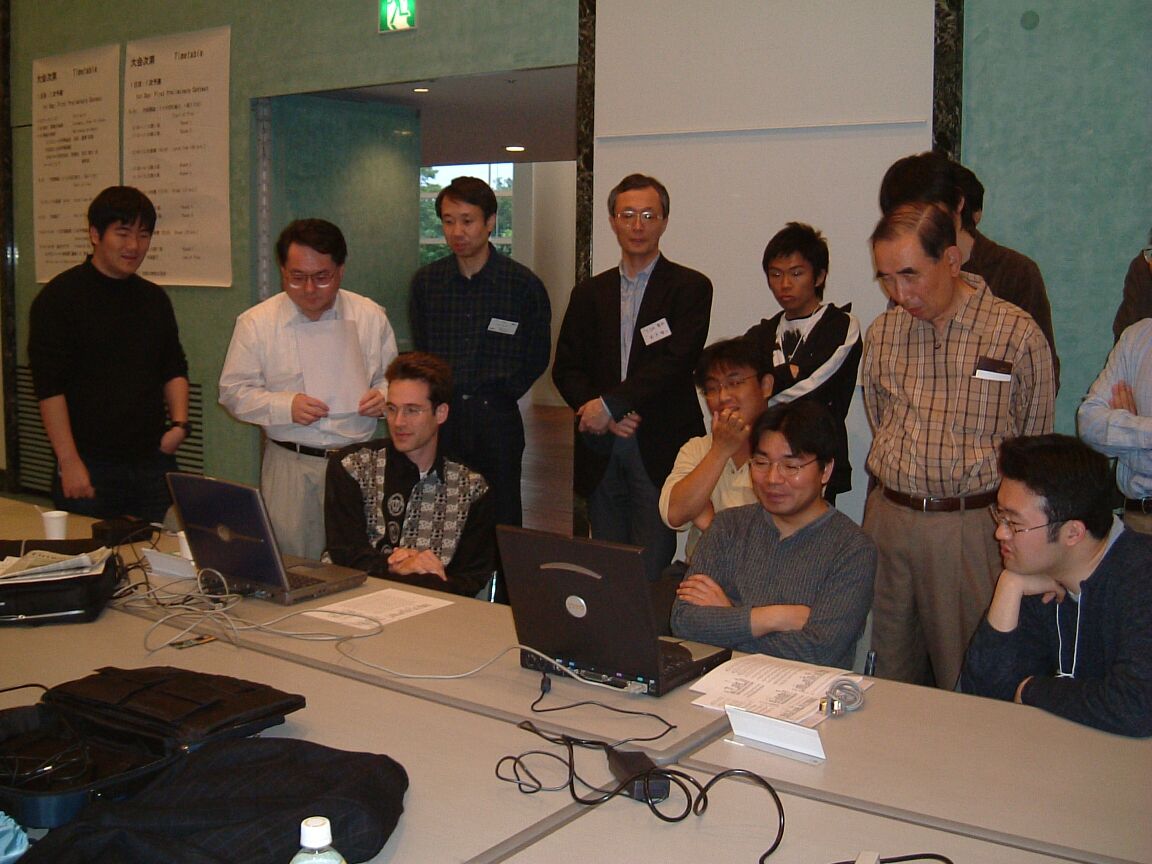
Pretending to be relaxed, but this was the make or break game.
There were no real surprises among the other programs that qualified for the
second day. K-Shogi, Aoi, Yano, Nazoteki-Denki and SPEAR had all dropped from
the second qualification round last year. Oki qualified for the first time, but
this was no big surprise, as the program actually qualified last year as well,
but had to withdraw for the second day because of a sudden hospitalization of the
programmer after the first day was finished.
Of the eight programs, the only program that qualified for the first time was Shuto.
Not a bad program, but it profited considerably from the tournament system. Losing
its first two games, it took the back road of the Swiss system and qualified without
playing any program ranked higher in the final standings. Tough luck for Mattari Yuchan,
who started very well and then was knocked back by strong opposition. Only Aoi had a
tougher schedule and I had the feeling that Aoi was actually the strongest program on the
first day. I was very happy not be paired with it in the final round.
Results of the first qualification round
No. Program Name 1 2 3 4 5 6 7 Pt SOS SB MD
* 1 GPS 12+ 16+ 5+ 2- 9+ 19+ 4+ 6.0 29.0 23.0 16.0
* 2 K-Shogi 24+ 14+ 4- 1+ 20+ 11+ 6+ 6.0 25.0 20.0 14.0
* 3 Oki 4- 13+ 24+ 20+ 18+ 10+ 5+ 6.0 21.0 16.0 11.0
* 4 Aoi 3+ 21+ 2+ 9+ 6+ 5- 1- 5.0 34.0 23.0 15.0
* 5 Yano7 23+ 17+ 1- 7+ 19+ 4+ 3- 5.0 28.0 16.0 10.0
* 6 Nazoteki-Denki 11+ 15+ 13+ 19+ 4- 9+ 2- 5.0 27.0 16.0 10.0
* 7 SPEAR 16+ 12+ 9- 5- 15+ 14+ 17+ 5.0 25.0 16.0 9.0
* 8 Shuto 9- 18- 16+ 12+ 14+ 13+ 10+ 5.0 23.0 17.0 10.0
9 Mattari Yuchan 8+ 10+ 7+ 4- 1- 6- 21+ 4.0 32.0 16.0 9.0
10 Maruyama 18+ 9- 14+ 23+ 11+ 3- 8- 4.0 25.0 10.0 5.0
11 Shiju-no-Tenarai 6- 22+ 21+ 17+ 10- 2- 16+ 4.0 24.0 9.0 5.0
12 Sugi 1- 7- 23+ 8- 13+ 22+ 15+ 4.0 24.0 8.0 4.0
13 Fuku 21+ 3- 6- 15+ 12- 8- 18+ 3.0 27.0 7.0 2.0
14 Ujiie 20+ 2- 10- 18+ 8- 7- 19+ 3.0 26.0 6.0 2.0
15 Yamada 22+ 6- 17+ 13- 7- 18+ 12- 3.0 23.0 6.0 2.0
16 Daemon 7- 1- 8- 24+ 22+ 20+ 11- 3.0 23.0 3.0 1.0
17 Sexy AIchan 19+ 5- 15- 11- 24+ 23+ 7- 3.0 20.0 3.0 1.0
18 Hayabusa 10- 8+ 20+ 14- 3- 15- 13- 2.0 26.0 7.0 0.0
19 HIT ver.0.02 17- 23+ 22+ 6- 5- 1- 14- 2.0 24.0 2.0 0.0
20 Ryoma 14- 24+ 18- 3- 2- 16- 22+ 2.0 21.0 1.0 0.0
21 Narikin 13- 4- 11- 22- 23+ 24+ 9- 2.0 18.0 1.0 0.0
22 Tsubakihara 15- 11- 19- 21+ 16- 12- 20- 1.0 20.0 2.0 0.0
23 Kuma 5- 19- 12- 10- 21- 17- 24+ 1.0 20.0 0.0 0.0
24 Inaka Shodan 2- 20- 3- 16- 17- 21- 23- 0.0 23.0 0.0 0.0
* GPS, K-Shogi, Oki, Aoi, Yano 7, Nazoteki-Denki, SPEAR and Shuto qualify for the
second qualification round.
The Second Preliminary Stage
Every year, the number of ex-finalists is growing a little in the second preliminary round,
which means that the number of favorites for qualification is growing. The usual suspects
were KCC, Eisei Meijin, Hyper Shogi, KFEnd, Kakinoki and Kanazawa. Furthermore, TACOS had
shown steady progress in the past couple of years, and might be ready to make the jump this
year. Also, Bingo Shogi could prove that last year's result was not a fluke. Already eight
programs for five spots and there was always the chance that programs like Ryu-no-Tamago or
Isobe, who had been close to qualification in the past, could cause an upset.
There were no big surprises in the first two rounds, even though TACOS lost in the second round
to Isobe. Kanazawa lost against Eisei Meijin and Bingo lost against Kakinoki, but these were
games among qualification favorites.
In round 3 the first big surprise: KCC lost to Ootsuki, which was not considered a favorite, but
now had started with three victories. For KCC this could have been a costly loss, but as it
turned out, the program won all its remaining games and qualified as the top program for the
finals.
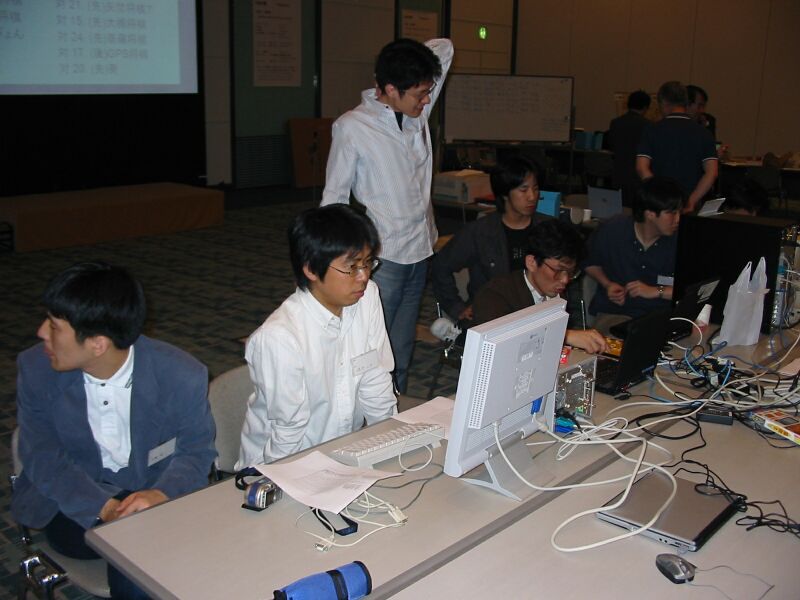
I expected a little bit more from Isobe Shogi this year.
That was basically it for the second day. Surprisingly, there were almost no
other surprises. Except for KCC and TACOS, the five programs that qualified all lost only to
programs that were ranked higher. Actually, TACOS qualified second by winning five straight games
after the loss to Isobe, including wins against Kakinoki, Kanazawa and Eisei Meijin.
A great run that was only stopped by a final round loss to KCC.
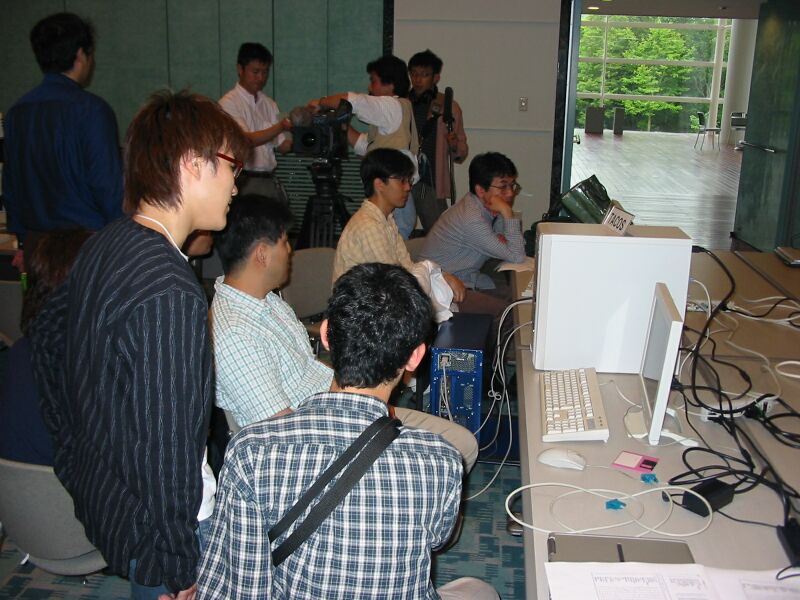
Well done, TACOS! The only new face in the finals (here they don't know that yet, though…).
Closest to qualification were Bingo and Kinoa. Bingo played Eisei Meijin and Kinoa played
Kakinoki in the final round and a victory by Bingo and Kinoa would secure qualification.
The programs could not pull it off, which meant that multiple tournament winner Kanazawa
sneaked in as the final program and the only program with three losses.
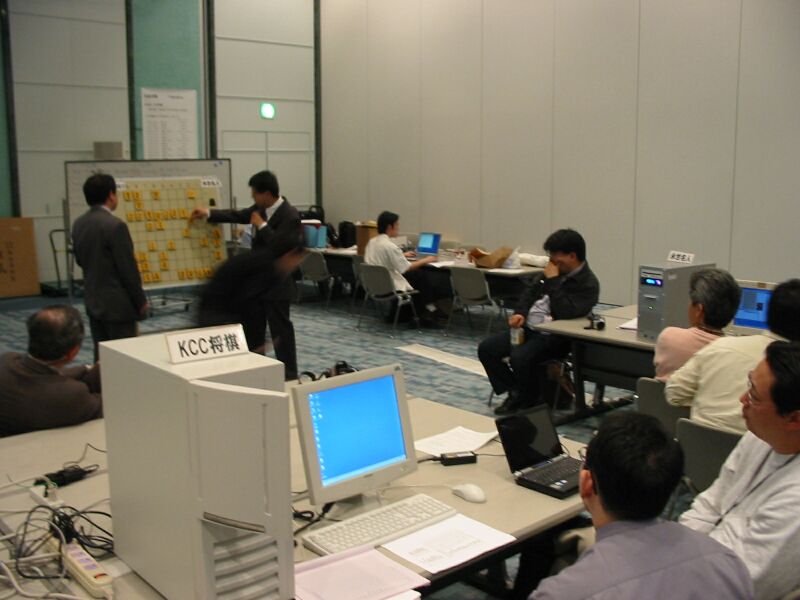
Explanations by Katsumata as the KCC team watches.
The prize for the most improved program should probably go to Nara Shogi, which ended
the hopes of last year's finalists Hyper Shogi and KFEnd. A great performance, but
losses against Kinoa and Bingo were too much to have a chance to reach the finals this year.
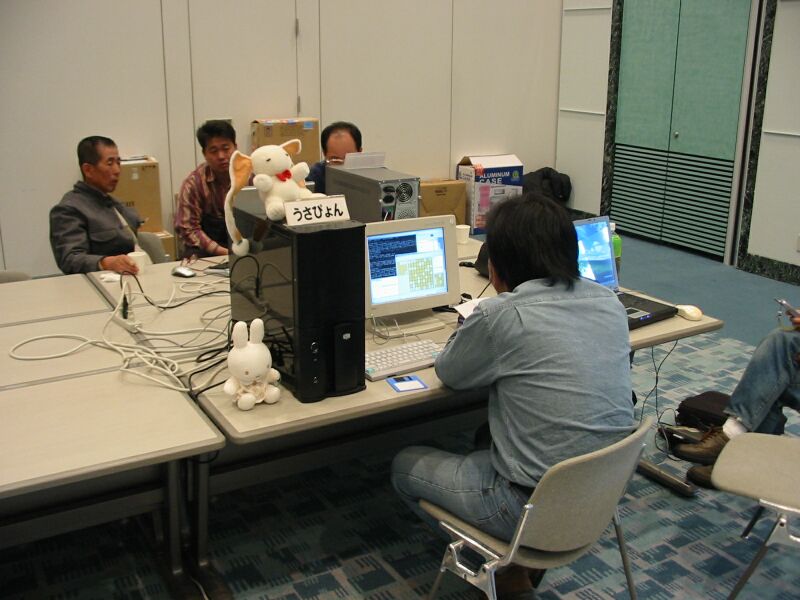
No rabbit out of the hat for Usapyon this year.
At the bottom of the table, the status quo was also maintained. Of the eight programs that qualified
on the first day, six programs went straight back down. Only Aoi and Nazoteki-denki took the seeded
positions from Sekita and Usapyon, but only by their fingernails, as they qualified 15th and
16th (there are 16 seeds).
SPEAR did as expected. I committed the deadly sin of game programmers, changing
important parts of the program on the evening of the first day. However, the risk
of having the program play worse were rather small and my overall impression was
that the games on the second day were much better than on the first day. Still,
it was not enough to win more than three games. The same result as last year, even
though I ended two spots higher. Hopefully, I will be able to do more work on the
program before next year's tournament.
Results of the second qualification round
No. Program Name 1 2 3 4 5 6 7 8 9 Pt SOS SB MD
* 1 KCC 23+ 8+ 14- 10+ 17+ 4+ 3+ 5+ 2+ 8.0 45.5 41.5 33.5
* 2 TACOS 19+ 11- 4+ 15+ 10+ 14+ 5+ 3+ 1- 7.0 49.0 36.0 26.0
* 3 Eisei-meijin 22+ 5+ 8+ 11+ 14+ 9+ 1- 2- 6+ 7.0 48.5 33.5 25.5
* 4 Kakinoki 18+ 6+ 2- 14+ 12+ 1- 13+ 9+ 8+ 7.0 48.0 33.0 24.0
* 5 Kanazawa 12+ 3- 11+ 7+ 18+ 6+ 2- 1- 13+ 6.0 51.5 29.5 20.5
6 Bingo 15+ 4- 13+ 19+ 11+ 5- 9+ 7+ 3- 6.0 47.5 27.5 18.5
7 Nara 8- 23+ 22+ 5- 9+ 10+ 14+ 6- 12+ 6.0 39.5 22.0 16.0
8 Kinoa 7+ 1- 3- 17+ 23+ 13= 22+ 19+ 4- 5.5 41.5 15.0 8.0
9 Hyper 10 17+ 13+ 10+ 12+ 7- 3- 6- 4- 20+ 5.0 46.5 20.5 12.5
10 KFEnd 16+ 21+ 9- 1- 2- 7- 17+ 20+ 15+ 5.0 43.0 17.0 10.0
11 Isobe 24+ 2+ 5- 3- 6- 18+ 19+ 12- 16+ 5.0 42.0 18.0 10.0
12 Sho-o 5- 22+ 24+ 9- 4- 17+ 18+ 11+ 7- 5.0 38.0 14.0 8.0
13 Ryu-no-Tamago 20+ 9- 6- 18+ 21+ 8= 4- 14+ 5- 4.5 42.5 13.0 6.0
14 Ootsuki 21+ 16+ 1+ 4- 3- 2- 7- 13- 19+ 4.0 49.5 18.0 7.0
15 Aoi 6- 18- 20- 2- 16+ 23+ 24+ 17+ 10- 4.0 33.0 9.0 4.0
16 Nazoteki-Denki 10- 14- 17- 20+ 15- 24+ 21+ 22+ 11- 4.0 30.0 9.0 5.0
17 SPEAR 9- 20+ 16+ 8- 1- 12- 10- 15- 24+ 3.0 40.5 8.0 3.0
18 GPS 4- 15+ 19+ 13- 5- 11- 12- 23+ 21- 3.0 38.5 8.0 3.0
19 K-Shogi 2- 24+ 18- 6- 20+ 21+ 11- 8- 14- 3.0 37.5 7.0 3.0
20 Usapyon 13- 17- 15+ 16- 19- 22+ 23+ 10- 9- 3.0 31.5 7.0 2.0
21 Sekita 9 14- 10- 23+ 22- 13- 19- 16- 24+ 18+ 3.0 27.5 5.0 1.0
22 Yano 7 3- 12- 7- 21+ 24+ 20- 8- 16- 23- 2.0 35.5 4.0 0.0
23 Shuto 1- 7- 21- 24- 8- 15- 20- 18- 22+ 1.0 35.5 2.0 0.0
24 Oki 11- 19- 12- 23+ 22- 16- 15- 21- 17- 1.0 30.0 1.0 0.0
* KCC, TACOS, Eisei Meijin, Kakinoki Shogi and Kanazawa qualify for the finals.
The Finals
On the day of the finals, the tournament always steps up. The qualification tournaments are great
for the programmers, but the finals are great for the spectators. The games are displayed on big
screens and commented by professional players. Especially Katsumata Kiyokazu is a professional
who has been coming to the CSA tournaments for a long time (he was already there when I first
came there nine years ago) and his comments are always very entertaining. This year there were
also comments by Kitajima Tadao, Iida Hiroyuki and the Lady professionals Yauchi Rieko, Takahashi
Yamato and Ajiki Fusako.
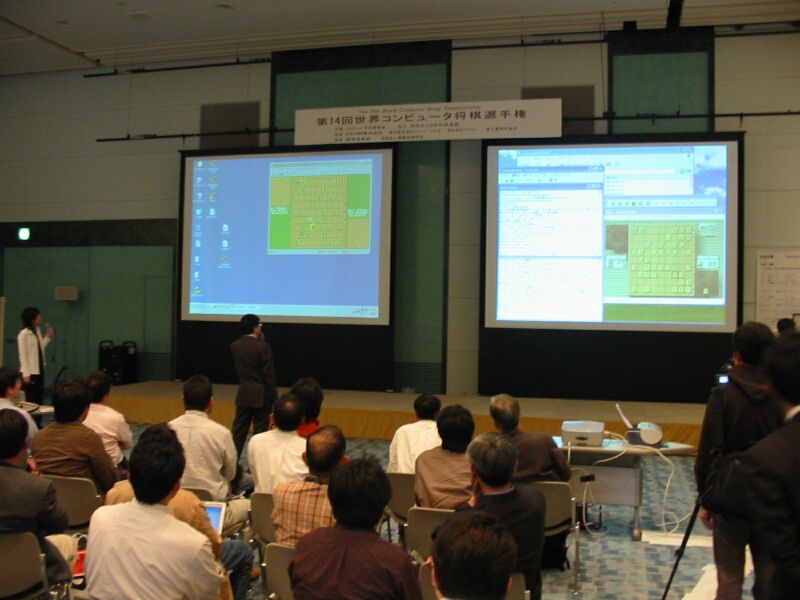
The final day brings out the big sceens.
Unfortunately, probably due to the fact that the Kazusa Arc is quite hard to reach, the number
of spectators seemed outnumbered by press, programmers and people from game companies. This was
a high profile event, where there were not only shogi journalists, but also reporters from national and
local newspapers and two camera crews, one of which was from the NHK, Japan's national broadcaster.
This is probably the only warning that could go out to the otherwise perfect organization: a venue
that is easier to reach might help to avoid that the CSA World Computer Shogi Championships turn
into a media-only event.
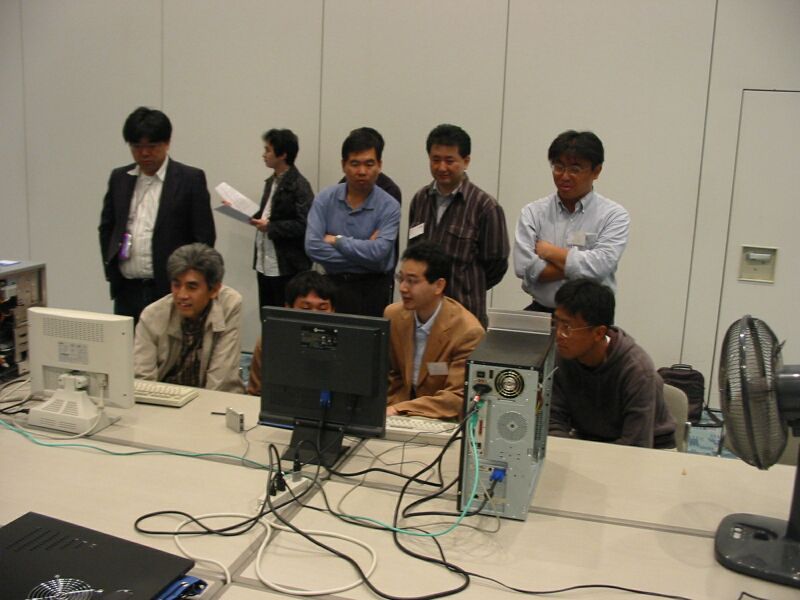
YSS (on the right) against Eisei Meijin (on the left).
As for the tournament, it really only started in the third round. In the first
two rounds, the top four programs won all their games, while the bottom four programs
lost all their games. The third round looked to be going the same way, but Kakinoki
managed to beat IS Shogi, which was an important setback for Tanase and Kishimoto's
bid for another CSA crown.
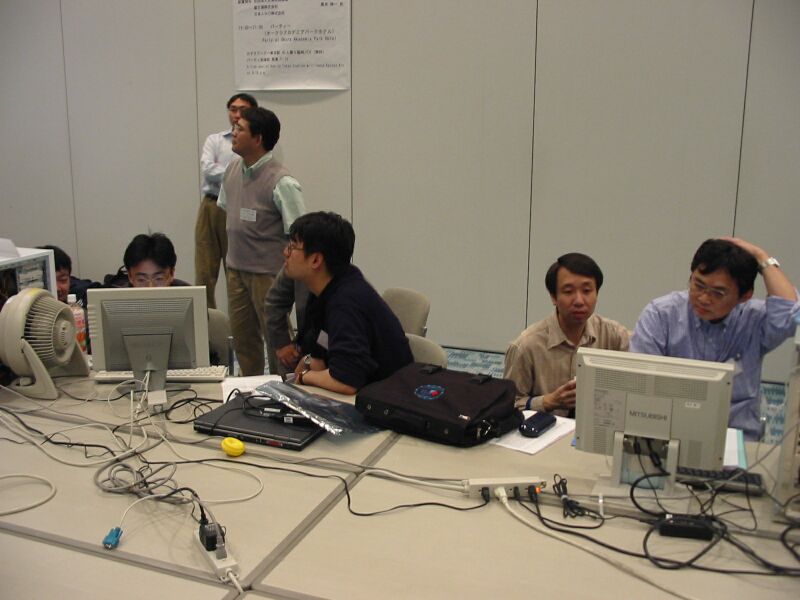
IS Shogi's Tanase dives into the screen, while Kakinoki scratches his head.
Round four saw another upset, as Gekisashi lost against Eisei Meijin. However, more important
were probably the events in the game between YSS and KCC. In an unclear middle game position,
something happened that is not often seen these days and almost never occurs in the finals:
KCC crashed. The reasons for the program failure were unclear (YSS's Yamashita thought it
might have been a hardware problem), but the organization declared YSS the winner. An important loss
for KCC, but it turned out to be an even more important win for YSS.
So after four rounds YSS was the only unbeaten program, followed by IS Shogi, Gekisashi and KCC.
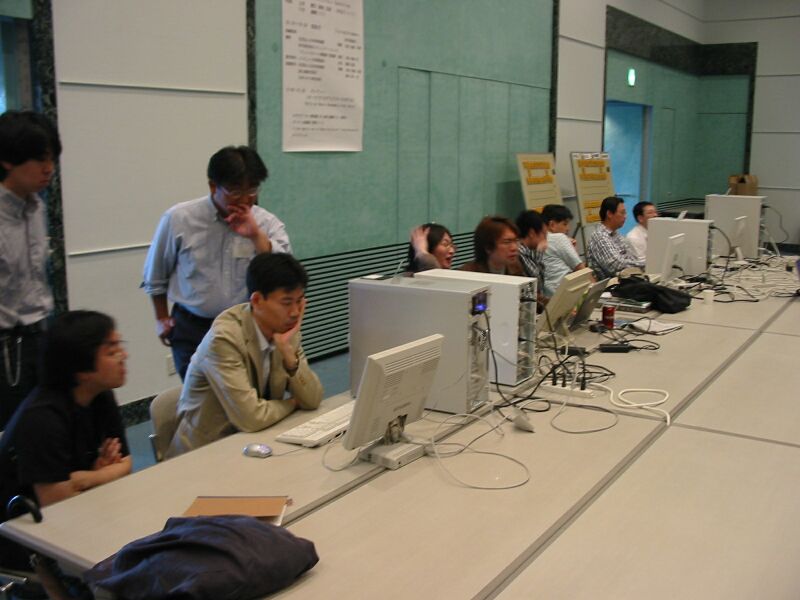
Gekisashi's Tsuruoka contemplating the program's moves, while Kanazawa joins the head-scratching contest.
In round 5, Gekisashi beat IS Shogi despite playing an anaguma, which doesn't seem to be its
favorite opening. As soon as Gekisashi entered the anaguma castle, the painful loss against
Jeff Rollason's Shotest two years ago came to mind, but Gekisashi's anaguma play seemed to have
been improved and this time Gekisashi won, virtually ending IS's reign as champions.
KCC did not crash, but it did lose surprisingly against Kakinoki, so this round also ended
all hopes for the North Koreans.
With only Gekisashi on one loss and the game YSS-Gekisashi in round 6, the tournament could be
heading for another early decision. Gekisashi in 2002 and IS Shogi in 2003 both started with
six straight wins, securing the tournament victory with one game in hand. YSS made it three years
in a row by winning the game against Gekisashi, ending the hopes of the spectators to see an exciting
final round. Yamashita of course didn't mind, although before the game he said that he did feel the
"evil eye" of almost everybody present.
This was the second time Yamashita won the tournament,
the first time was already 7 years ago. After the final game of that tournament Yamashita broke down
in tears, but no big emotions today. Yamashita is a great sportsman and the freely awarded
win against KCC was bothering him.
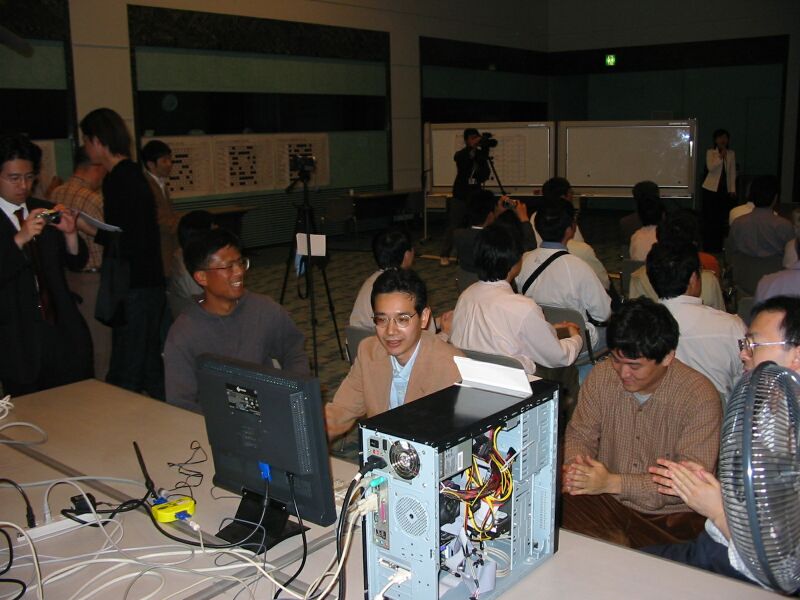
Gekisashi has just resigned; The moment Yamashita waited seven years for. No tears this time…
So, in the final round there were only the three seeded positions to play for. IS Shogi
was in the biggest danger of falling back to the preliminary qualifications, because a loss to
YSS would do it. However, they showed the heart of champions by winning, denying YSS a perfect score.
This perfect score is becoming a jinx, as last year and the year before the same thing
happened: the program already certain of victory losing in the final round.
One would almost think the programs relaxed a bit...
Gekisashi also defended its seeded position with a victory against KCC in the final round. This means that
all five programs that came up from the qualifications have to try their luck in those qualification rounds
again next year.
Results of the finals
No. Program Name 1 2 3 4 5 6 7 Pt SB MD
1 YSS 8+ 5+ 6+ 4+ 7+ 2+ 3- 6.0 18.0 12.0
2 Gekisashi 5+ 7+ 8+ 6- 3+ 1- 4+ 5.0 14.0 9.0
3 IS 7+ 6+ 5- 8+ 2- 4- 1+ 4.0 12.0 5.0
4 KCC 6+ 8+ 7+ 1- 5- 3+ 2- 4.0 10.0 5.0
5 Kakinoki 2- 1- 3+ 7- 4+ 6- 8+ 3.0 9.0 4.0
6 Eisei Meijin 4- 3- 1- 2+ 8+ 5+ 7- 3.0 9.0 3.0
7 TACOS 3- 2- 4- 5+ 1- 8- 6+ 2.0 6.0 0.0
8 Kanazawa 1- 4- 2- 3- 6- 7+ 5- 1.0 2.0 0.0
The Programs
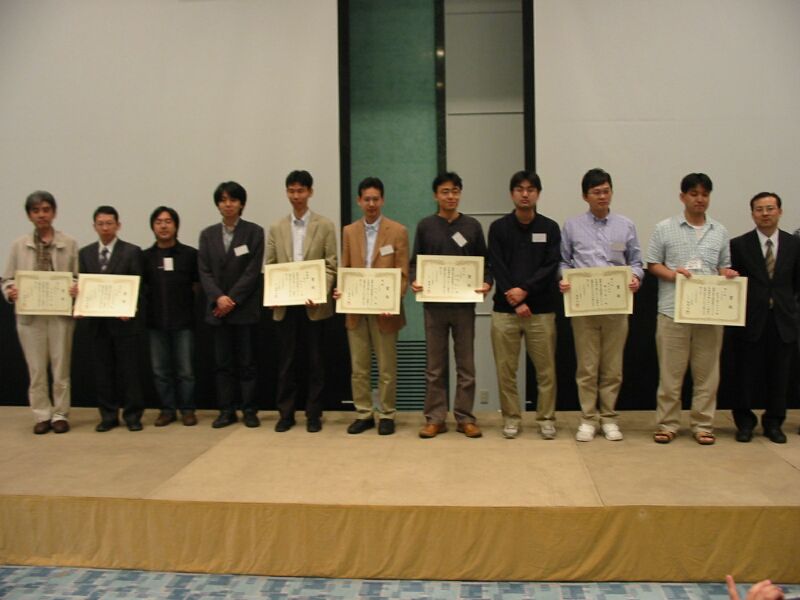
The finalists with their diplomas. Not many happy faces, but I am sure they were all very tired.
- YSS: A great result for Yamashita, winning the CSA tournament after seven years. He also
showed that it is still possible to win without a team effort. Last year, I wrote here that it is
almost impossible to win the tournament on your own, but Yamashita just went out and did it.
- Gekisashi: Tsuruoka's group was a little bit disappointed with their result. Their
impression was that Gekisashi was much improved and they had a strong feeling that they could
win it this time.
- IS Shogi: Losing three games is quite a rare experience for Tanase and Kishimoto (last time
they lost three was in the 1999 championships).
They blamed their problems on their opening book, which was extended too much and
lead IS Shogi in positions it did not fully understand.
- KCC Shogi: Despite being among the top finishers every year, the KCC team seems to be the most
unstable program in the finals. Last year they had problems with sennichite and this year the program
even crashed. In that sense, it is remarkable that they managed to get the same result as last year.
- Kakinoki: Back in the finals after a year absence. Beat both IS and KCC, which is quite
good, but to win the tournament more consistency is needed.
- Eisei Meijin: Yoshimura again managed to qualify for the finals and such
consistency is becoming increasingly difficult in today's computer shogi. Still, Eisei
Meijin will need important improvements to take on the big names. An accidental victory
like against Gekisashi is not enough.
- TACOS: Hashimoto and his team came a long way to finally make it to the finals
and victories against Kakinoki and Eisei Meijin showed their potential. Whether or not TACOS can grow
into a real contender, we will probably know next year.
- Kanazawa: A sad conclusion for those who have been following computer shogi for
such a long time, but the days of Kanazawa seem to be over. Winning the tournament multiple times
is something that will be in the books forever, but this year's performance showed that last
year's failing to qualify was no coincidence. Kanazawa only barely qualified for the finals
and made no impact whatsoever, winning its only game against TACOS.
Conclusions
Computer Shogi seems to have reached a status quo that is very hard to break. It is very
difficult to take one of the seeded positions on the second day (only two programs did so),
it is very difficult to take one of the five qualification spots for the finals (only TACOS
was a new entry) and it is very difficult to beat the top programs in the finals (the top
three programs were the same as last year).
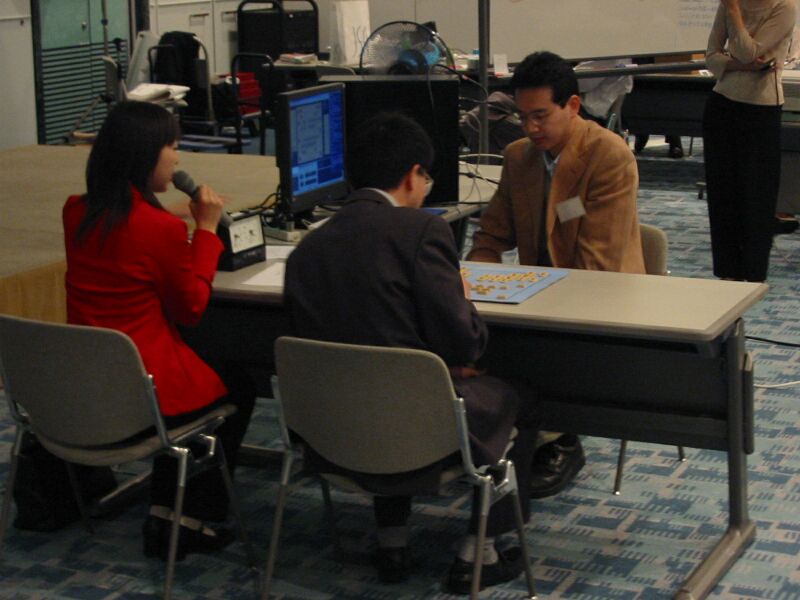
YSS challenges professional shogi player Katsumata with a rook handicap.
Because of this status quo, my overall impression was that the level of play had not
improved much. There are a number of reasons why this assessment might not be correct.
First, last year's winner IS Shogi only barely managed to keep its seeded position.
Second, talking to the top programmers, they all had test results that showed a
significant improvement compared to last year's programs. Third, YSS won a rook handicap
game against Katsumata after the tournament. This is only one game, but it is the first time
that a computer program beats a professional with such a small handicap.
So, instead of going with my initial impression, I think it is better to say that a lot of
programs have improved considerably and that the fundamentals of the top programs are sound.
Instead of new major breakthroughs, careful tuning and programming a little bit more strategic
understanding might be good enough to start a move towards beating professional players.
Of course, new ideas are always welcome and in that sense it is alarming that there were almost
no new entries this year and that the number of participants was the lowest in 6 years. I think the
CSA has an important task here to try and attract more participants to the tournament.
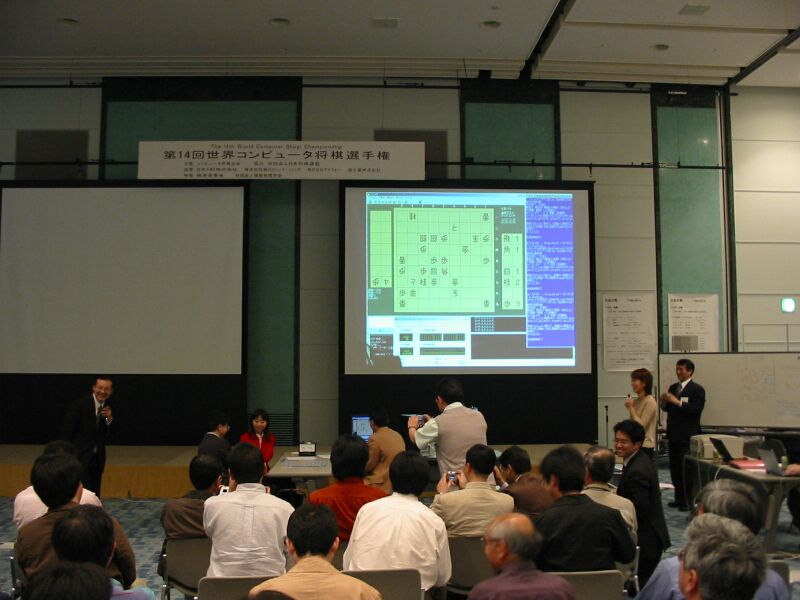
Another important step forward for computer shogi. In this position Katsumata has just resigned.
A game from the finals
[Black "YSS"]
[White "Gekisashi"]
[Event "14th World Computer Championships, Round 6"]
[Date "May 4th 2004"]
1.P7g-7f 2.P8c-8d 3.P6g-6f 4.P3c-3d 5.R2h-7h 6.P8d-8e 7.B8h-7g 8.S7a-6b 9.K5i-4h 10.K5a-4b 11.K4h-3h
12.K4b-3b 13.K3h-2h 14.B2b-4d 15.L1i-1h 16.P1c-1d 17.G4i-5h 18.P1d-1e 19.K2h-1i 20.K3b-2b 21.S3i-2h
22.P5c-5d 23.G6i-5i 24.G6a-5b 25.G5i-4i 26.S3a-3b 27.G4i-3i 28.B4d-5c 29.P5g-5f 30.P7c-7d 31.S7i-6h
32.P4c-4d 33.S6h-5g 34.N8a-7c 35.S5g-4f 36.P8e-8f 37.P8gx8f 38.B5cx8f 39.R7h-8h 40.B8fx7g+ 41.R8hx8b+
42.+B7gx9i 43.P7f-7e 44.+B9ix6f 45.P7ex7d 46.N7c-6e 47.P7d-7c+ 48.B*8d 49.+P7cx6b 50.+B6fx3i 51.S2hx3i
52.B8dx3i+ 53.S*2h 54.S*3h 55.S2hx3i 56.S3hx3i+ 57.B*2h 58.P*8a 59.+R8bx8a 60.S*3h 61.B2hx3i 62.S3hx3i=
63.R*3h 64.L*2d 65.S*3f 66.L2dx2g+ 67.S3fx2g 68.B*4i 69.P*2h 70.B4ix3h+ 71.S2gx3h 72.G5b-5c 73.B*7e
74.R*7h 75.B7ex5c+ 76.G*4b 77.+B5cx4b 78.G4ax4b 79.G*4i 80.P*7a 81.B*6f 82.P5d-5e 83.B6fx3i 84.P5ex5f
85.+R8ax9a 86.P5f-5g+ 87.S4fx5g 88.N6ex5g+ 89.B3ix5g 90.P*5f 91.B5g-6f 92.S*5g 93.G5hx5g 94.P5fx5g+
95.B6fx5g 96.B*4e 97.+R9a-8b 98.G*4a 99.P*5b 100.B4e-6g+ 101.+R8b-8g 102.R7h-7f+ 103.+R8gx7f
104.+B6gx7f 105.P5b-5a+ 106.P*5f 107.N*1d 108.K2b-3c 109.+P5ax4a 110.S3bx4a 111.R*3a 112.S4a-3b
113.S*2b 114.K3c-4c 115.L*5e 116.R*5d 117.G*5c 118.K4cx5c 119.R3a-5a+ 120.G4b-5b 121.+R5ax5b
122.K5c-6d 123.+R5bx6c Resigns


